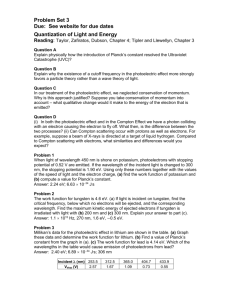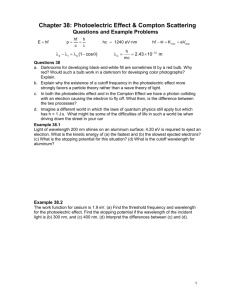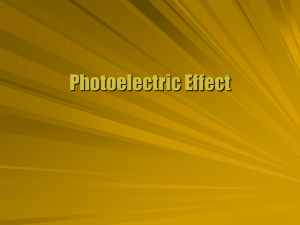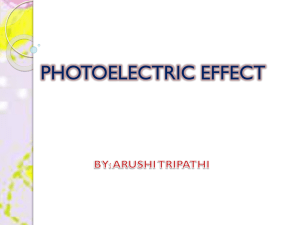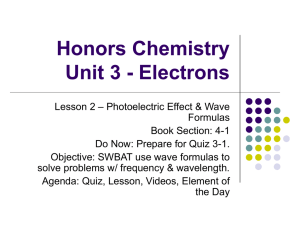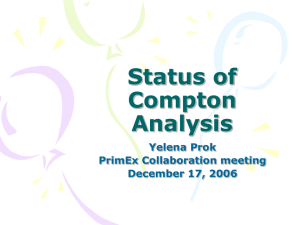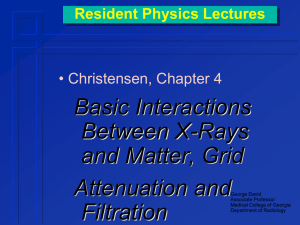2.8-2.9
advertisement
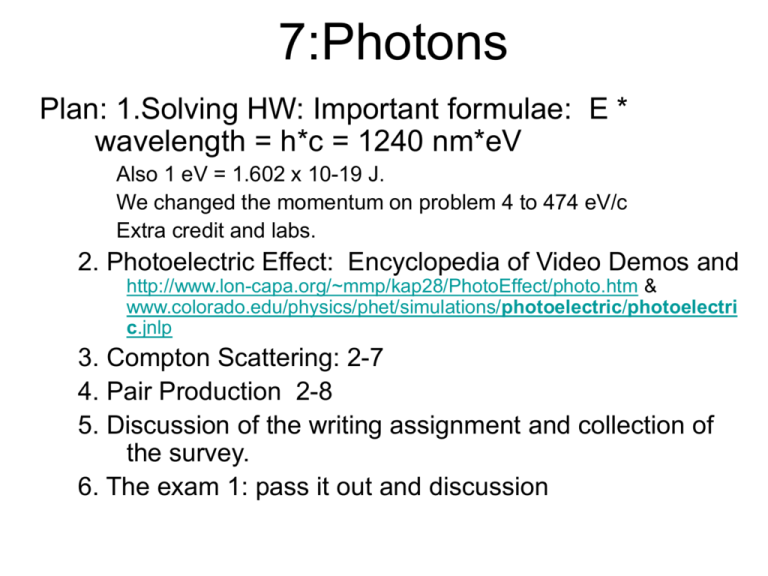
7:Photons Plan: 1.Solving HW: Important formulae: E * wavelength = h*c = 1240 nm*eV Also 1 eV = 1.602 x 10-19 J. We changed the momentum on problem 4 to 474 eV/c Extra credit and labs. 2. Photoelectric Effect: Encyclopedia of Video Demos and http://www.lon-capa.org/~mmp/kap28/PhotoEffect/photo.htm & www.colorado.edu/physics/phet/simulations/photoelectric/photoelectri c.jnlp 3. Compton Scattering: 2-7 4. Pair Production 2-8 5. Discussion of the writing assignment and collection of the survey. 6. The exam 1: pass it out and discussion Did you complete at least 70% of Chapter 2? A. Yes B. No The photon was originally called a “light quantum” (das Lichtquant) by Albert Einstein.[5] The modern name “photon” derives from the Greek word for light, φῶς, (transliterated phôs), and was coined in 1926 by the physical chemist Gilbert N. Lewis, who published a speculative theory[9] in which photons were “uncreatable and indestructible”. Although Lewis' theory was never accepted—being contradicted by many experiments—his new name, photon, was adopted immediately by most physicists. Isaac Asimov credits Arthur Compton with defining quanta of light as photons in 1927.[10][11] http://en.wikipedia.org/wiki/Photon In the photoelectric effect, no electrons are emitted if the frequency of the light is ______ than the cutoff frequency. A. greater B. less Photoelectric Effect • Sodium Metal • Blue light electrons Red light no electrons Blue light: Kmax ≈ 0.5 eV http://hyperphysics.phy-astr.gsu.edu/hbase/imgmod2/pelec.gif Photon—quantum of light •Work function- minimum energy needed to eject an electron •Sodium Ø = 2.4 eV Energy of photon E = hf blue light, hf = 2.9 eV red light, hf = 1.9 eV • Kmax = hf - Ø http://hyperphysics.phy-astr.gsu.edu/hbase/imgmod/pelec5.gif Extra Credit Activity (2 points) SIM: Photoelectric Effects Run the photoelectric effect simulation at http://phet.colorado.edu/new/simulations/sims.php ?sim=Photoelectric_Effect Perform the simulation with several sets of parameters. Write a paragraph about how the simulation supports the discussion of the photoelectric effect from the book and any insights you gained from performing the simulation. You may include figures or a table if you'd like. 7. (1 point) • A silver ball is suspended by a string in a vacuum chamber and ultraviolet light of wavelength 200 nm is directed at it. What electrical potential will the ball acquire as a result? On line “experiment” • www.colorado.edu/physics/phet/simulation s/photoelectric/photoelectric.jnlp • Millikan and students provided the data that gave Einstein the Nobel. But it took m time to get happy with light as particle. • http://focus.aps.org/story/v3/st23 X Rays • • • • • Discovered in 1895 by Roentgen Generated when electrons hit target Materials transparent to them Not deflected by magnetic field Roentgen saw no interference and little diffraction! • Bragg diffraction – explained in 1912 • X rays are EM waves with wavelengths from 0.01 to 0.10 nm X-Ray Tube + Tungsten Target Anode - Filament Cathode Bragg Diffraction θin=θout θ d Bragg Diffraction 2d sin(θ) = m λ θ d Bragg Diffraction What do X-Rays Have to Do with Quantum Mechanics? Compton Effect • Compton noticed that x-rays were “softer” after they had passed through a substance. • Compton showed that this could be explained by treating scattering as “collision” between a photon of light and a particle of matter In the Compton effect, the scattered photons have _____ energy than the incident photons. A. more B. less Compton Scattering of a “Photon” Before After ee- Are you pondering what I’m pondering? Yes, but how will we ever get that many rubber bands? No you buffoon! Why do you need x-rays to see this? Compton Shift Consider the Compton effect. Which of the electrons shown would you expect to be knocked out with more energy? (pp) A. B. A B Consider the Compton effect. Which of the scattered photons shown has the longest wavelength? (pp) Assume the incident photon have same wavelength. A. B. Pair production • Suppose I have a steep, really long hill and get going 0.99c and hit a bump, Can I make energy into mass? • What happens to that new mass as it goes down the hill can it make new mass, too? Review if needed If we apply a constant force on an object, the acceleration of the object, as it approaches the speed of light, will _______. (pp) A. decrease B. increase C. remain constant

